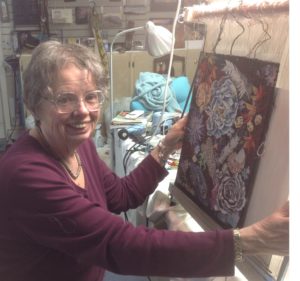
Just me
My page is blank.
The piece on my loom half finished (only a slightly fudged on the actual reality), but I wove for 2.5 hours today. I practiced my yoga for an hour meditated for 30 minutes. A day of enuff, But, my promised written page on tapestry is still blank- an unfulfilled promise to myself. It’s time to be a yes and fill up the page with a tapestry topic-one small page…to follow.
So—-
I choose to think about tapestry as a journey or practice created pass by pass (a single over and a back of the weft bundle) or rather as a series of half passes (a traverse of the weft bundle in one direction). The smallest unit of the pass is a half pass/Demi- duite and the smallest unit of a half pass/demi-duite is a magical dot. One time over creates a dot. When stacked and two colours are used you create a line that runs up and down instead of across. Each dot has incredible
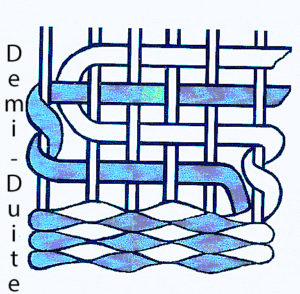
Demi duite or half pass
possibilities as the weft bundle is composed of multiple strands of colour and texture waiting to embellish each dot with multiple possibilities. The Magical Dot is created where the weft bundle crosses a warp(s), or it becomes valley and disappears when it passes behind a warp(s) or a series of dots until completed with a second half pass and becomes a line. Multiple passes become whatever I choose each line to become or be! An over and back creates a line. A true yes to all of the possibilities of thousands of magical dots.
All that said-there is still a beginning and an ending of a pass or Demi-duite. Beginnings and endings or the tails of the weft bundles are often determined by whose tradition your weaving in. Most “traditional techniques are based on practical concerns-time honored repeatable successes of what worked best for the materials on hand and passed on weaver to weaver. But, all that said if you’re not fortunate to have been

duite or pass
born into those wonderful traditions…which I was not…Maybe these musings of a long-time tapestry weaver can offer you a starting point…
what are you weaving with? Is it slippery such as threads, embroidery floss, silk, rayon or stiff such as linen, bast fibers or other extremely stiff materials? Are they hairy fibers that will felt or adhere to each other when beaten in or combed?
How will the finished piece be used? Is it meant to be double sided? Meant to be worn? Will it hang as a mural sized piece? Or be on a wall on framed. What is the warp sett. How many ends will you be dealing with? Another consideration when beginning and ending especially when working in small format (anything above 16 wpi I consider small format). is how to get rid of the ends. If one leaves enough ends on the back of a tapestry say in an area with there are many colour changes and the hand of the fabric is extremely light the mass of ends on the back may not allow the tapestry to lie flat or be mounted flat. Half of the ends can be eliminated by larks heading around a warp to begin. Others can be eliminated by larks heading to the end of the weft bundle where the yarn of the weft bundle doubles back into the weft bundle.
-
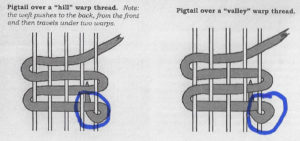
Pigtails can be the easiest or the hardest thing to do. It's all because of the over or under. Sometimes it the pigtail passes 2 warps other times it on one warp. It will always default to an over or an under.
Pig Tails can be done from the front or back and will tug the tail and hug the tail in place and two the center back. My favourite way! Also learned with my Gobelin instructors and later when I began to weave from the front. I just reversed the direction of the pigtail. It can be a bit confusing for the first couple of times until you realize the trick. It has to do with the hills and valleys. Sometimes you need to go behind to warps and sometimes one warp. Remember the idea is to default so that you always have an over and under. See video attached. A bit of history or myth to add interest- Why are they called pigtails. Is part of the licenses that came with being a Gobelin weaver in the 17th They were allowed or given pigs that had particularly curly tails and a license to brew beer, an apartment, vegetable garden and a few other perks as part of their pay for being Gobelin weavers.
2. Sometime After I had my first Gobelin style class with Ruth Tannenbaum in 1978 we were weaving from the back of the tapestry and someone had the idea of tying an over hand knot one he tail up next to the weaving surface We then cut the ends right up to the knot. Short and concise, but a pain to do with thousands of ends.
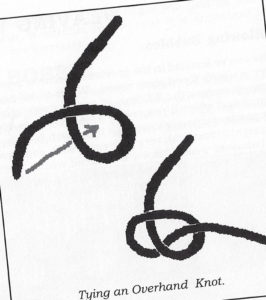
Tying overhand knotsin the weft one way to end or begin.
3. Grading the ends is a trick that works well with soft fuzzy wools. Cut the end of the weft bundle at an angle and weave it. Grade the next weft bundle and begin it on top of the last weft. I have found that I need to use scissors as I lack the control of most Navajo weavers to tug and pull so it breaks at an angle at just the right place.
4. For me one of the more difficult ways to get rid of a weft end is-threading most often with a needle the extra weft back through the Channel next to the warp. Nice at larger warp setts, but at 22 epi and many, many, many weft ends an impossibility
5. Another way is to tack down the wefts with needle and thread on the back after first knotting them into group and then tacking down the wefts on the back.
6. another choice would be leaving ends hanging on the back and trimmed to a .25 inch Not a good choice if your using slick, smooth and non-hairy wefts. Well- even this can become a design element if left on the surface.
7. Begin with a larks head and end with a pigtail or however.

Beware of the beak. The bar can look like a mistake on larger warp setts if it is on the front of the tapestry.
When using larks head knots that the weft in the knot where it crosses un and down. That line can be on the front or back of the weaving depending on the direction you first loop through. It doesn’t matter so much when your weaving at very small weft setts because the bar is too small to see. BUT, if your weaving at larger warp setts it can create a vertical looking bar that will look like a mistake. So if you see the bar reverse the direction you begin to loop through to reverse the side the bar is on. The other really nice thing about a larks head and getting rid of ends-If you start a weft bundle with a larks head you can easily pull one end to the back and weave with the other end as your weft bundles and your rid of half of the ends.
8. Another way of beginning other than a pigtail is to begin with larks heading the weft bundle to a warp.
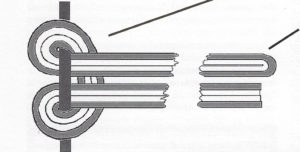
The bar I wrote about that you need to watch on the back where you need it to be.
When larks heading to a warp one needs to be careful that the bar of the loop on the larks head knot lies to the back of the tapestry. If you don’t a small vertical line will be on the surface of the tapestry and will read as a mistake at larger warp setts. It’s easy to just twist the larks head around the warp until the right side of the lark’s head is on the surface and the bar is to the back of the tapestry
All of these techniques plus more can be found in my 3 books-Tapestry 101, Line in Tapestry and Shaped Tapestry.
Well here's My page. My page is filled. My promise to myself now kept!
A page or a little more to create my practice or Asana.
A special Thank you to my Wednesday group for both support and aid in two very special projects. Thank you Jan, Ken, Linda, Sharon and Pete for helping hang the Outcomes Exhibit at Eugene Textile Center. I hope you all go and see the Exhibits. I have or have some wonderful students that are have become incredible tapestry weavers. A second thank you goes to Sharon, Linda and Jan for the help and support for the things happening this weekend.

Asa's Rocks IT'S FINALLY WHERE IT BELONGS. lOVE YOU GUYS!